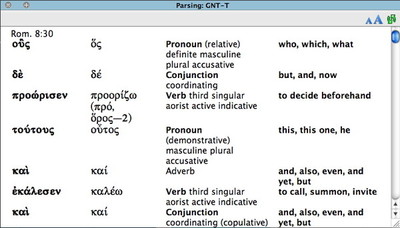I have a confession to make. When I was taking Greek in seminary, I didn’t always come to class fully prepared. I know, it’s hard to believe—especially in light of how consistent I’ve been with the blog this week—but I’m afraid it’s all too true. There were times when I came to class without my translation assignments completed, and I would sit through class just hoping I wouldn’t be called on to read my translation or parse something. I’m sure none of you reading this can relate.
On my desktop at home, I had Accordance and could get quick parsing help via the Instant Details, but laptops were prohibitively expensive back then, and even if I had one, my professor probably would have frowned on my using it in class. Then I found a poor man’s solution to getting help in class: the Parse button on the Resource palette.
The Parse button gives you the parsing information displayed in the Instant Details for every word you select. So on those days when I didn’t get my assignments done, I would select every word in the assigned passage, click the Parse button, and print the contents of the Parsing window.
Once I discovered this Accordance equivalent of Cliff’s Notes, Greek class became much less stressful:
“Mr. Lang, would you please parse ἐκάλεσεν?”
“Sure thing! It’s the third person singular aorist active indicative of καλέω.”
Oh how self-assured and confident I appeared from that day forward!
The other day someone asked a question on our forums that reminded me of the insanely great power of the Parsing window. Far more than a crib sheet for unprepared students, the Parsing window can be customized in a variety of ways. I’ll show you some of those in the next couple of posts.
Of course, any professors reading this should know that I do not condone this sort of behavior among your students! 😉


